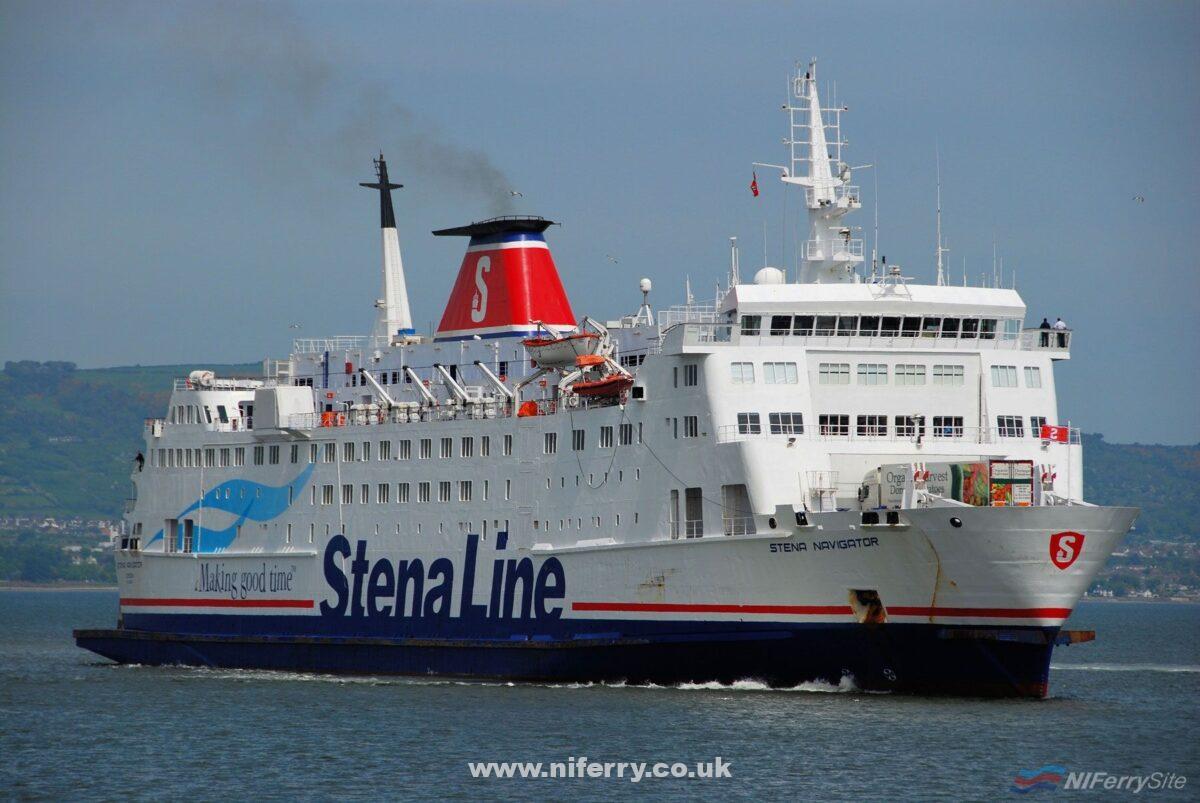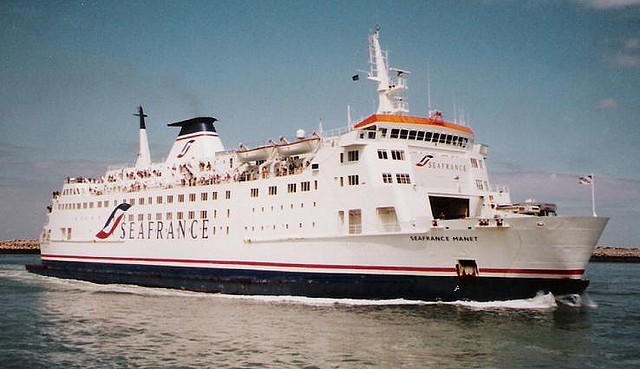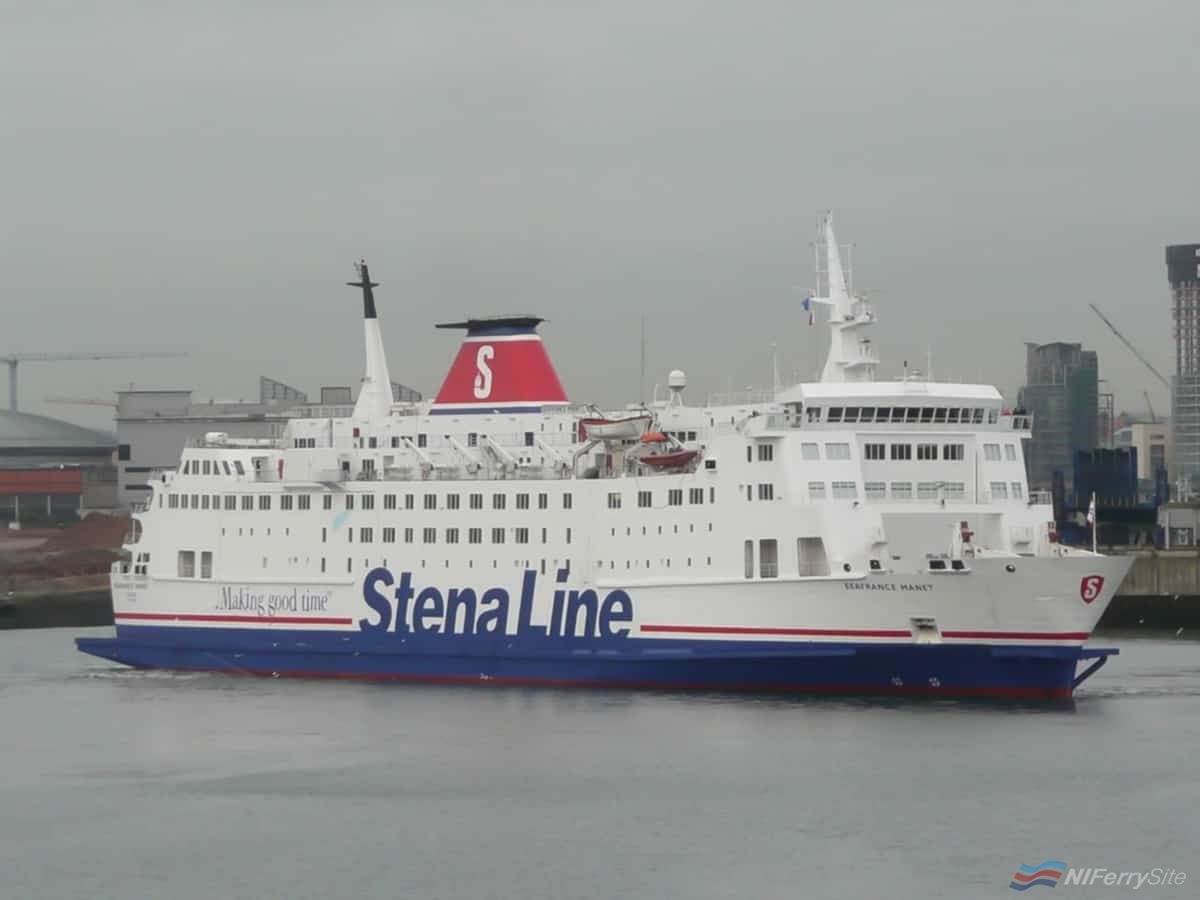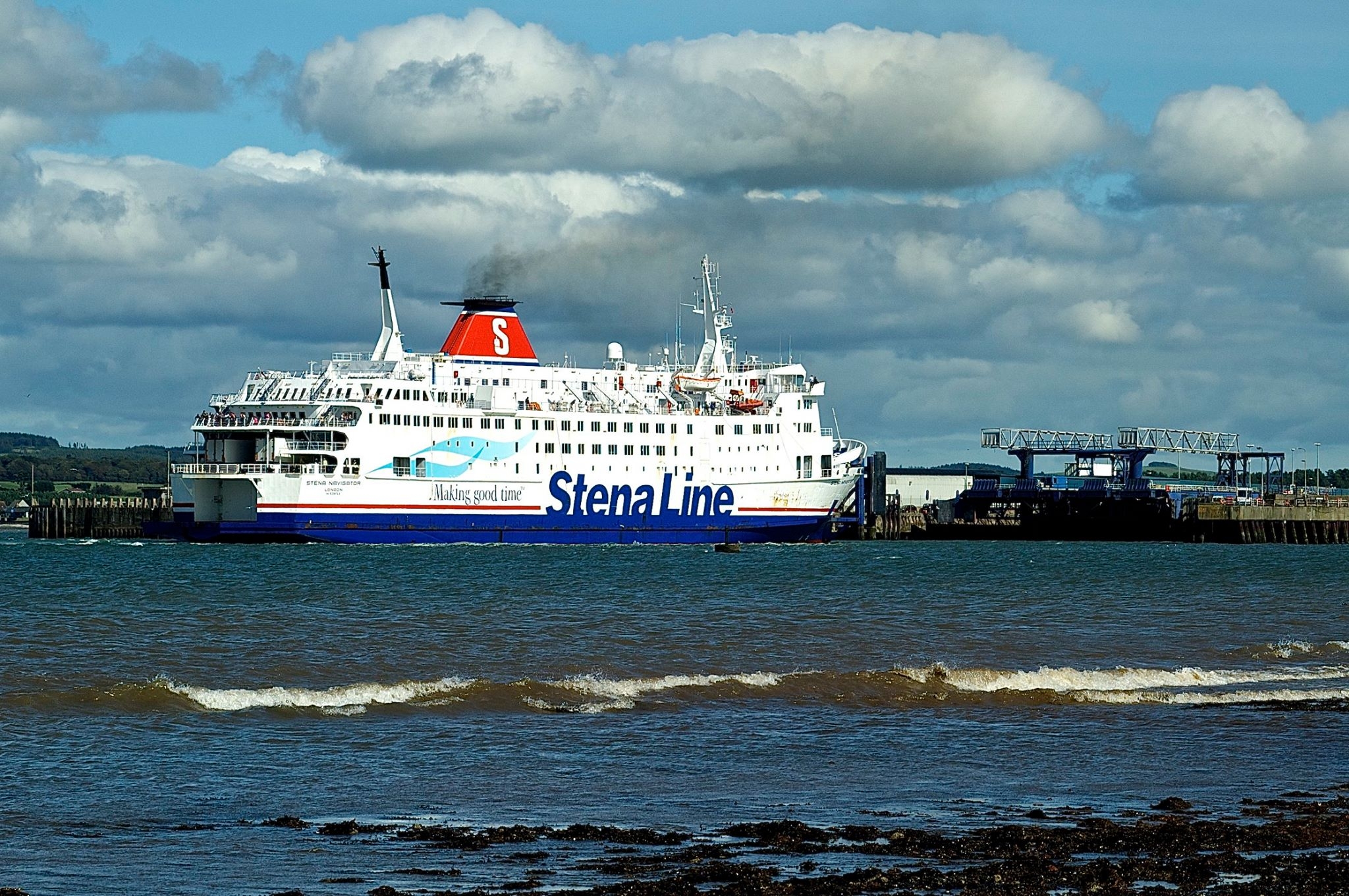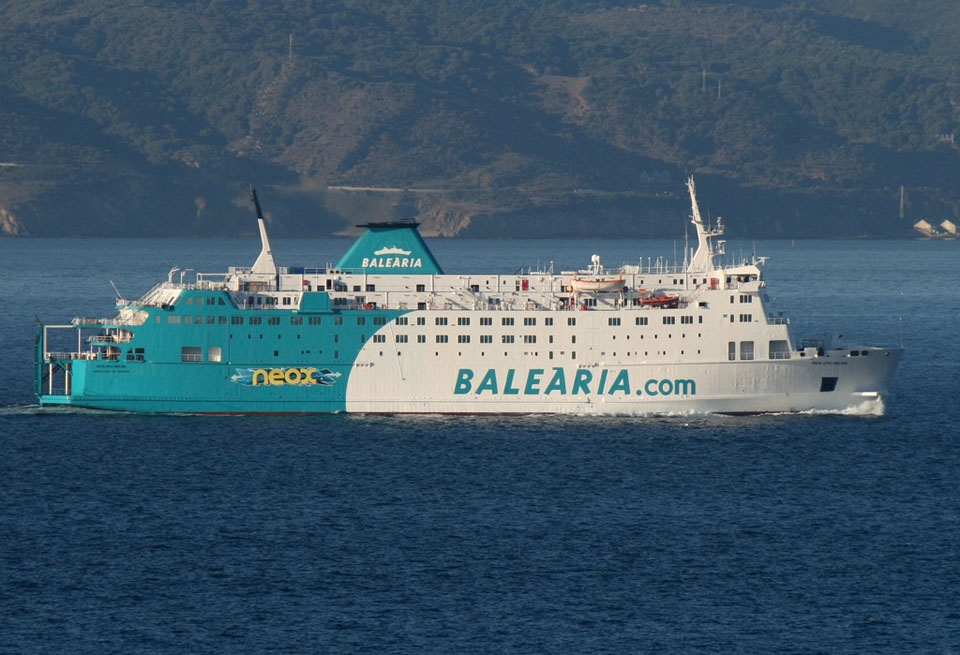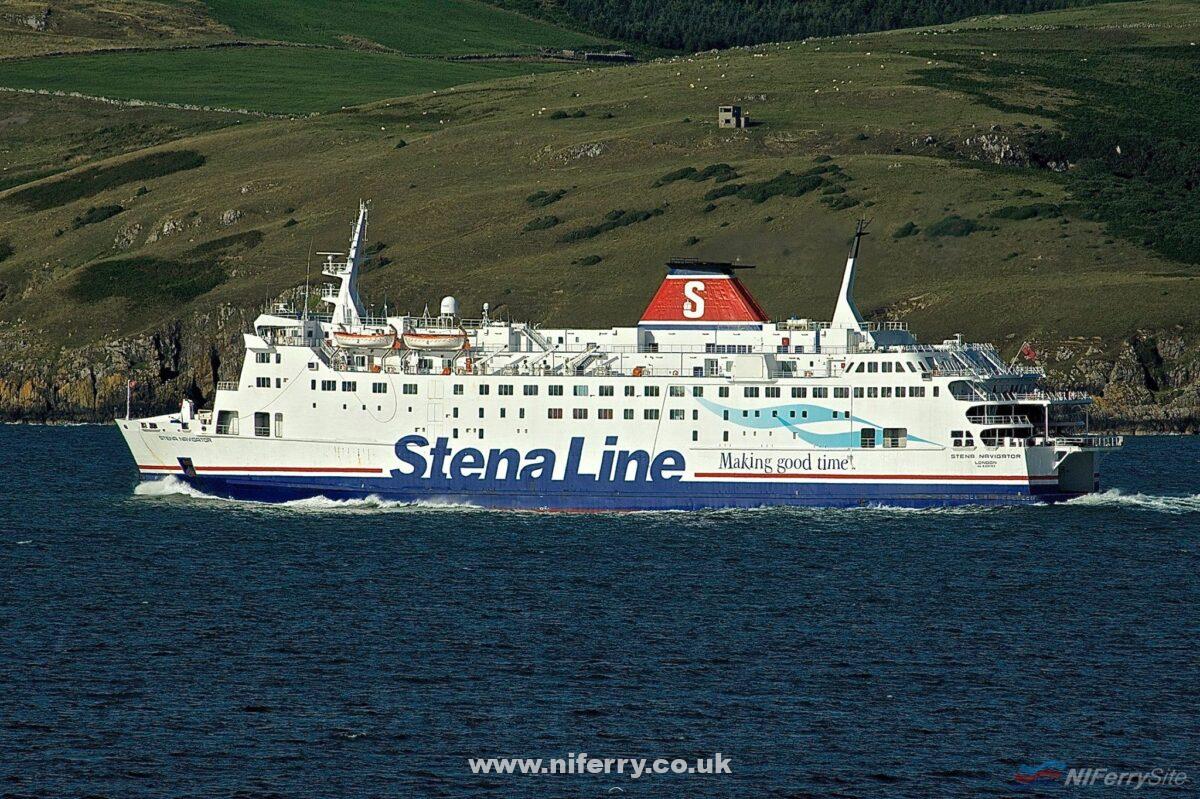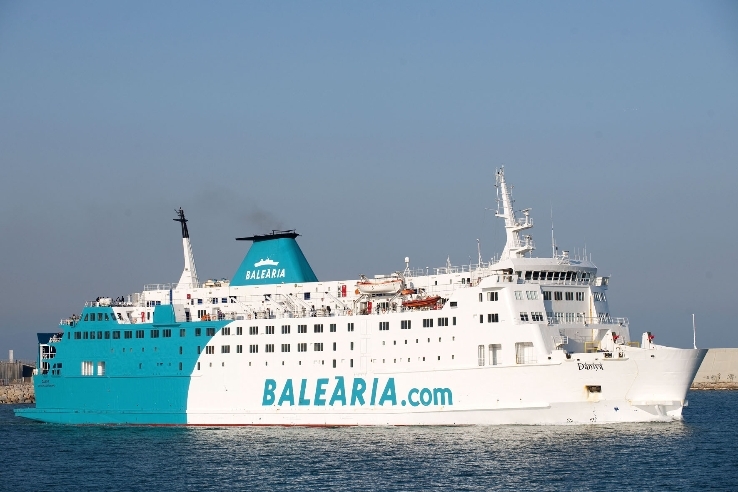Poeta Lopez Anglada Fast Facts
| Current Name: Poeta Lopez Anglada | Previous Names: Previously DANIYA, STENA NAVIGATOR, SEAFRANCE MANET, STENA PARISIEN, CHAMPS-ÉLYSÉES |
| Shipyard: Chantiers Dubigeon S.A., Nantes [FR] #167, | IMO Number: 8208763 |
| Current Operator: Balearia | Current Route: Algeciras [ES] - Tangier Med [MO] |
| Length Overall: | Beam: |
| Passenger Capacity: 1257 | Vehicle Capacity: 800 lane metres of freight or 243 cars |
| Tonnage: | Sister-ships: Related to and based on the design of Cote d'Azur (later Seafrance Renoir) but not a sister-ship |
STENA NAVIGATOR arrived in late 2009 as the second conventional ship on Stena Line’s Belfast – Stranraer service. She was introduced to provide extra capacity to STENA CALEDONIA, which by then was the sole conventional vessel operating to Stranraer. This allowed sailings by the expensive to operate HSS 1500 craft HSS STENA VOYAGER to be further reduced.
Stena Navigator History
STENA NAVIGATOR was originally ordered during spring 1982 by SNCF Armemant Naval (later SNAT (Société Nationale d’ Armement Transmanche)) to operate services from Dover to Calais and Boulogne as CHAMPS-ÉLYSÉES under the Sealink banner (in cooperation with British Rail).
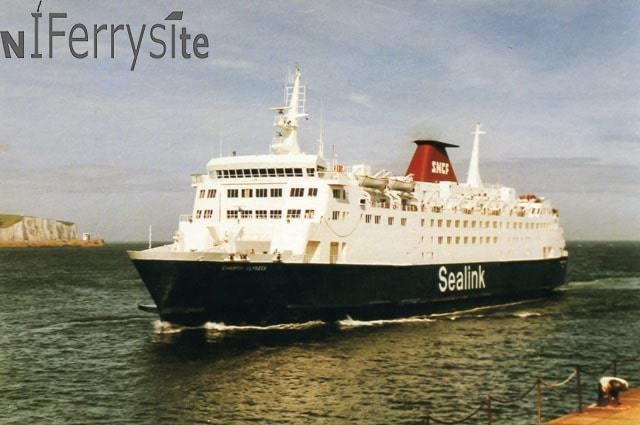
At the time of her introduction she was the highest capacity vessel in service for Sealink across the Dover strait. Another of those vessels was the Belfast build St. David, which later became the Stena Caledonia following her transfer to the North Channel. Having operated together in their early years as a result of the pooling arrangement between Sealink (British Rail) and SNCF on the Dover to Calais route, ST. DAVID and CHAMPS-ÉLYSÉES would also end their UK careers together on the North Channel as STENA CALEDONIA and STENA NAVIGATOR.
Newhaven – Dieppe
During 1990 CHAMPS-ÉLYSÉES was rebuilt over a period of 3 months at Dunkerque, following which she was transferred to the Newhaven – Dieppe route, entering service on July 2nd 1990. Following repetitive strike action on the Newhaven – Dieppe route (as a result making it the most unreliable ferry service in North Western Europe), Sealink-SNAT (the then operator) announced that the route would close and be sold at the end of April that year. However, the crews had anticipated this announcement and already gone on strike (again) in protest 4 days earlier! CHAMPS-ÉLYSÉES was strikebound at Dieppe, though her running mate, VERSAILLES, had been moved to Le Harve and was empty of strikers.

To the surprise of many, Sealink Stena Line, who until that point had a share in the ownership of the vessels (through a concern they owned with SNCF/SNAT called SPN established in 1990, which they had a 49% stake in), were the buyers of the route. Sealink Stena Line wasted no time in restarting the route, having moved the VERSAILLES to Southampton were she was renamed STENA LONDONER (registered in the Bahamas) and repainted in their livery, she resumed service on the 22nd of May with a British crew.
CHAMPS-ÉLYSÉES was still strike-bound on the normal Dieppe berth, so STENA LONDONER used the freight berth in Dieppe’s inner harbour. Realising their cause was lost, the striking french crew walked off CHAMPS-ÉLYSÉES, allowing her to leave for Southampton 4 days later, where she was overhauled, renamed STENA PARISIEN, and repainted in Sealink Stena Line colours at A&P Appledore.
However, the former CHAMPS-ÉLYSÉES retained her Dieppe port of registry and was crewed with French seamen, albeit on a no-strike agreement. STENA PARISIEN re-entered service from Newhaven and Dieppe on the 3rd of June, still part-owned by SNAT (SNCF) but chartered to Sealink Stena at a favourable rate.
SeaFrance, and a return to Calais
Since the Stena takeover of Sealink British Ferries in May 1990, relations between Stena and operating partner of the Sealink services from Dover, SNAT (Societe Nouvelle d’Armement Transmanche) had been rather “strained”. This culminated with the announcement by SNAT on the 12th July 1995 that they would not be extending the operating agreement with Stena, and that the partnership on the Dover – Calais route would terminate on 31st December that year. From then on they would operate independently under the brand of SeaFrance.
When the charter agreement for STENA PARISIEN expired on 10th January 1997 she was no longer required on the Dieppe route. This followed a down-turn in its fortunes after a bright start under Stena ownership.
STENA PARISIEN was sent to Dunkerque for a £1 million overhaul, during which she was renamed SEAFRANCE MANET. She entered service for SeaFrance on the 20th January 1997 between Dover and Calais effectively replacing her former running mate, SEAFRANCE MONET (formerly the STENA LONDONER and VERSAILLES), and operating alongside her older part-sister, SEAFRANCE RENOIR (formerly CÔTE D’ AZUR), upon which her design had been based.
Following impressive growth (capturing some 20.4% of the passenger market and 38.2% of the maritime freight market on the Dover strait), SeaFrance announced in 1998 that they were prepared to invest some 2 billion French francs in their fleet over the next 5 years, but any decision would be made after the effects of the end of duty free on 30th June that year had been assessed.
During 1999, Stena Line sold their 49% stake in SPN to SeaFrance, using the funds to part-fund the acquisition of Scandlines routes in Scandinavia. At the end of 1999, SeaFrance had decided to invest in a new ship in order to start to seriously challenge their competitors on the route, the joint venture between P&O and Stena Line (P&O Stena Line), who were deemed to have more modern and higher quality ferries.
Serious interest was apparently shown in Irish Ferries ISLE OF INISHMORE which would become surplus at Dublin once ULYSSES arrived. However, as she was not available until 2002 and no other vessel deemed suitable was available, a new-build was considered to be the only option. Although it was preferable for the company to build any new ship in France, no French yard had the space to accommodate the building of the new ship.
Two European and a single Asian yard were short-listed, with the letter of intent signed in early April 2000 with the Aker Finnyards facility at Rauma (Finland) for a new ship costing some 600 million French Francs. The new ship, SEAFRANCE RODIN commenced service on the 29th of November 2001. In March 2005 a second new-build, SEAFRANCE BERLIOZ, this time built at the French yard of Chantiers de l’ Atlantique at St Nazaire, arrived.
It had been expected that as the oldest ship in the fleet, SEAFRANCE RENOIR would then be deactivated, but in September 2005 it was SEAFRANCE RENOIR which replaced the newer SEAFRANCE MANET which was relegated to ‘freight ship’ status. This was due to “Renoir” having had a much more recent refit, thus her passenger accommodation was in better condition.
During spring 2007, SeaFrance were considering ordering a third new-build based on the Rodin design, as the “Renoir”, “Manet”, and “Cézanne” (the former FIESTA and sister ship to Sealink’s FANTASIA) were from a different generation of ferry and somewhat smaller than their running mates. This made them uneconomic to continue to run. These ships had also not benefited from any major investment in some time, meaning they were in need of refurbishment in order to upgrade their accommodation to a similar standard to the newer ships.
Ultimately though, despite an assessment being made of available shipyard space in Europe, SeaFrance purchased the JEAN NICOLI (the former SUPERFAST X, and a sister to STENA SUPERFAST VII and VIII, which became STENA SUPERFAST X) at the end of 2007 for some 105 million Euros. This was despite having made a significant operating loss of 20.5m Euro’s that year!
Initially JEAN NICOLI would be leased back to previous owners SNCM. During February and March 2008, SeaFrance lost 5m Euro as a result of strike action. It was announced that the SEAFRANCE RENOIR would be withdrawn immediately, and SEAFRANCE MANET in 2009 in order to try and return the company to profit.
The JEAN NICOLI was delivered to SeaFrance in April 2008, and was sent to ARNO Dunkerque for conversion to day use, having previously been used on long overnight services such as the Rosyth – Zeebrugge operation.
In anticipation of the newly converted ships arrival, SEAFRANCE MANET was withdrawn from service on the 29th April and laid up, initially in Calais, then Dunkerque from late December 2008. Even with the withdrawal of both SEAFRANCE MANET and SEAFRANCE RENOIR, and the introduction of the newly converted JEAN NICOLI as SEAFRANCE MOLIERE, SeaFrance posted a trading loss of 22 million Euro for 2008.
In 2009 following crisis talks, it was decided that only ‘Rodin’, ‘Berlioz’ and ‘Moliere‘ would be operated with SEAFRANCE CÉZANNE also now laid up.
Stena – a second Life away from the Channel
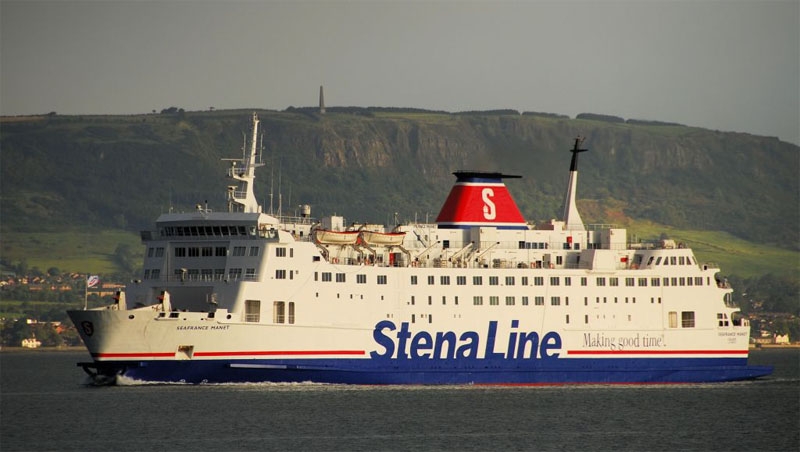
On July 8th 2009, Stena Line announced that they had acquired the SEAFRANCE MANET for the Belfast – Stranraer operation. This had surprised some, as she was said to have been in poor condition having not received major attention since 1997. This was in addition to having been laid up with little maintenance for over a year.
However, there was a shortage in the number of ferries available which could fit the berthing constraints in Stranraer whilst being large enough to be viable to run on the North Channel operation as a passenger and freight vessel. In the event, SEAFRANCE MANET‘s former operating partners, SEAFRANCE RENOIR and SEAFRANCE CÉZANNE, which had seen service more recently, did not find any buyers within the ferry industry and where sold for scrap (somewhat controversially to India), perhaps demonstrating the lucky escape SEAFRANCE MANET had.
On August 27th 2009, SEAFRANCE MANET entered the dry-dock at Dunkerque for a full overhaul and repaint, expected to last 3 weeks. She emerged from the dry-dock on the 23rd of September, arriving in Belfast 2 days later with a SeaFrance delivery crew, in full Stena Line livery but still carrying the name SEAFRANCE MANET.
Stena’s latest vessel had not been extensively refurbished since 1996 as only painting and essential mechanical work had taken place under SeaFrance since her initial refit for them. In order to prepare the latest addition to the Stena Line fleet for her new service and bring her up to Stena Line standards, a comprehensive refurbishment designed by Stena’s house naval architects, Figura Arkitekter, and was carried out by Newry based MJM Marine alongside at Belfast.
STENA NAVIGATOR received the Shippax award for the Best Ferry Conversion of 2009 and was the fourth major refit for the vessel since her building (the others being for SNCF in 1990, Stena Line in 1992, and Seafrance during 1996).
Perhaps inevitably, given she had been out of regular service for over 18 months, STENA NAVIGATOR‘s early career on the North Channel was plagued by technical problems, in addition to delays caused by bad weather. Notably, she suffered a partial failure of both engines on October 15th 2011.
However, STENA NAVIGATOR went on to prove herself to be capable running mate to STENA CALEDONIA and the HSS STENA VOYAGER during the 3 years before Stena’s move from Stranraer to the new facility called Loch Ryan Port.
Balaeria, and a new life in the sun
During March 2011, Stena Line announced that they had agreed to charter Superfast VII and Superfast VIII from Estonian company, Tallink. The newly chartered ships would operate from Belfast to a new port near Cairnryan in Scotland which was under construction. They would replace all 3 Belfast – Stranraer vessels on their introduction.
The 20th November 2011 was a significant day in the history of North Channel ferry operation, as it was the day the last ferry service from Stranraer. This marked the end of almost 150 years of ferry operations from Stranraer to Northern Ireland.
Following the introduction of the newly refurbished Superfast twins the following day, STENA NAVIGATOR, STENA CALEDONIA, and HSS STENA VOYAGER were all laid up in Belfast awaiting sale, STENA NAVIGATOR having completed her final commercial sailing on Wednesday the 16th November.
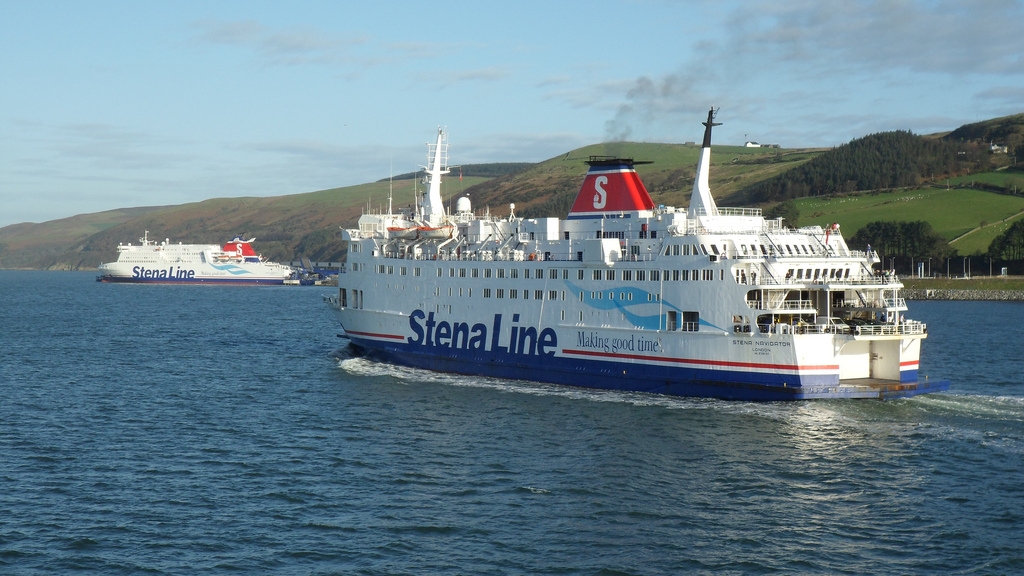
It didn’t take long for a buyer to surface for STENA NAVIGATOR, with Spanish operator Baleària Eurolíneas Marítimas S.A (Baleària) known to have been in talks with Stena even before she was laid up. However, the sale to Baleària wasn’t completed until February 2012, with STENA NAVIGATOR leaving Belfast for the last time, bound for dry-docking in Santander on 16/02/2012.
STENA NAVIGATOR was still in full Stena livery and still carried her Stena name in contrast to STENA CALEDONIA which had been already renamed with her Stena Line logos painted over before she left Belfast after her sale.
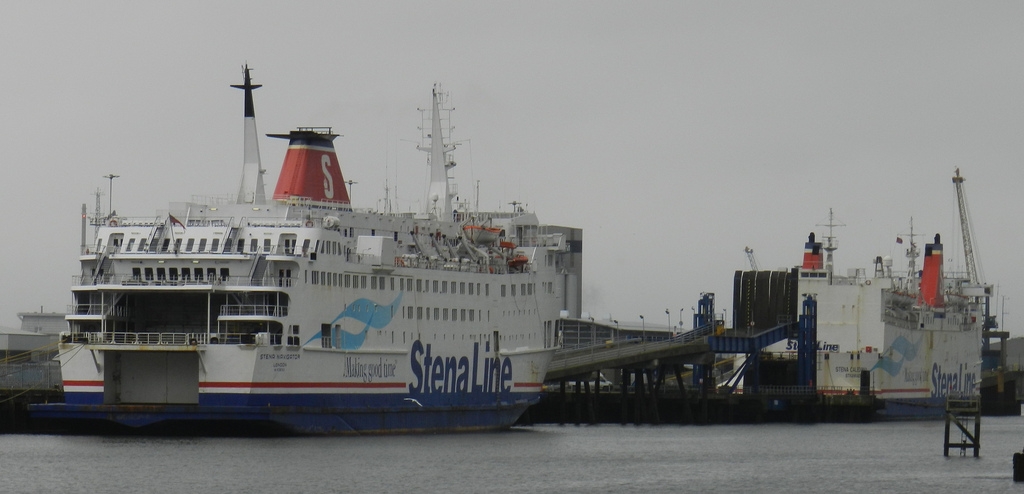
On 20th February, STENA NAVIGATOR arrived at the dry-dock in Santander. She re-emerged on the 9th of March in Balaeria livery, renamed DANIYA and registered in Santa Cruz de Tenerife. She entered service for Balaeria during April between Denia – San Antonio – Palma, and Denia – San Antonio – Barcelona, with much of her Stena interior (including brands such as ‘Barista’) intact.
Given that she had only operated on the North Channel for 3 years following a complete refurbishment, and been well looked after by her Stena crew (in contrast to the latter part of her career with SeaFrance), much of the interior was still like new when she finished service with Stena Line (see below photos from Baleària).
During November 2013, DANIYA was renamed POETA LÓPEZ ANGLADA and moved first to the Algeciras – Ceuta route, and then the Alcudia – Ciutadella route just 2 weeks later. She returned to the Algeciras – Ceuta in July 2014 and continues to operate that route at the time of writing (though she has had the odd spell covering on other services such as Denia – San Antonio).
During February 2016 POETA LÓPEZ ANGLADA was fitted with a new bow ramp to improve the loading and discharge of vehicles in port, along with modifications to her bow in order to accommodate this. The work was conducted at Astilleros del Guadalquivir in Sevile, and at the same time as she was also surveyed and repainted.
Awards
Shippax award for the ‘Best Ferry Conversion of 2009’
Trivia
STENA NAVIGATOR‘s 3 diesel generator engines are of a rare type manufactured by the now defunct French manufacturer Duvant-Crepelle. Duvant-Crepelle themselves were later taken over by Wärtsilä France.
Title image: Stena Navigator arriving in Belfast 03/06/2010. Copyright © Alan Geddes.
Technical information
| Technical Data | POETA LÓPEZ ANGLADA (ex Daniya / Stena Navigator / Seafrance Manet / Champs-Élysées) |
|---|---|
| IMO Number | 8208763 |
| Design | |
| Building Yard | Chantiers Dubigeon S.A., Prairie-au-Duc, Nantes, France. |
| Hull Number | 167 |
| Keel Laid | 30/11/1982 as Champs-Élysées |
| Launched | 20/12/1983 |
| Completed | 02/10/1984 |
| Conversion Yard (for Stena) | ARNO Dunkerque, France
Refurbishment conducted alongside at Belfast by MJM Marine. |
| Conversion completed | Dry-docking completed 23/09/2009. Arrived in Belfast on 25/09/09 in Stena livery but still named SeaFrance Manet and with SeaFrance delivery crew. Renamed Stena Navigator on 8/10/09, registry London whilst undergoing internal refurbishment. Sea trials conducted on 29th October 2009. Entered service 12th November 2009. |
| In service (original) | 4/10/1984 (for SNCF) |
| In service (Stena Line) | 12/11/2009 as Stena Navigator |
| Call sign (Stena Navigator) | FNMS, 2CRW3
(currently EADS for Balaeria) |
| Length overall (Between perpendiculars) | 130.00m (122.30m) |
| Beam | 23.02m |
| Draft | 5.022m |
| Gross Tonnage | 15,093 |
| Machinery |
|
| Power(Max/Pme @ 75%) | 15,840/11,880kW |
| Operational speed | 18kts |
| Fuel consumption | Approx 35t/24hrs at service speed |
| Capacity (as built) |
1800 passengers 43 commercial vehicles or 300 cars |
| Capacity (as Stena Navigator) |
1192 passengers 280 cars or a mix of cars and commercial vehicles (approx 850 lane metres vehicle deck space) |
| Crew (as Stena Navigator) | Minimum of 48, fluctuating with demand. |
| Onboard Facilities (as Stena Navigator) |
(See below for a full floor plan from 2009) |
| Flag |
Santa Cruz de Tenerife (current) London (as Stena Navigator) Calais (SeaFrance) Nantes, Calais, Dieppe (SNAT/SNCF) |
Deck Plan (as Stena Navigator)
Click the image below to view a larger version.
Additional photographs

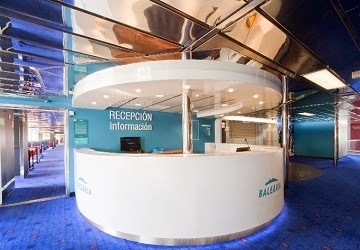
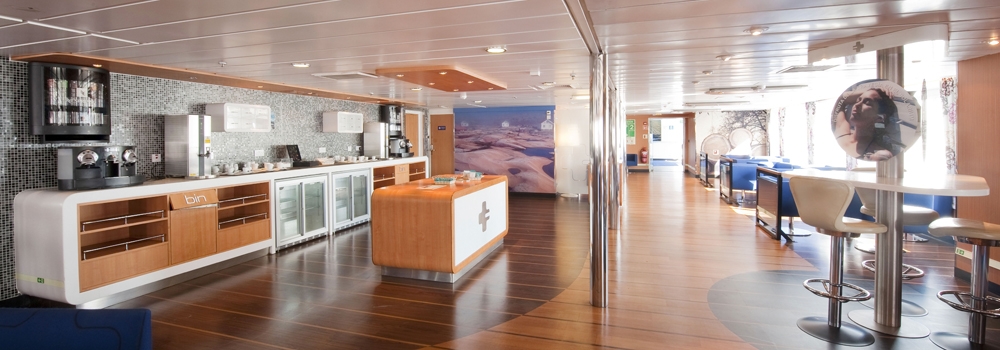
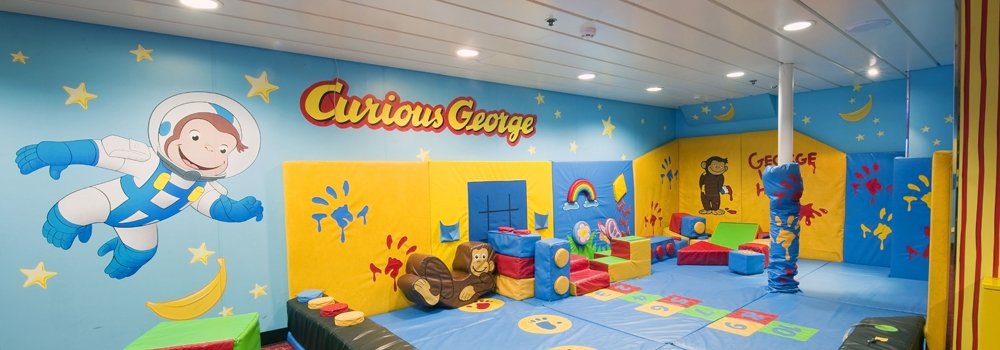
Video

Article Copyright © Steven Tarbox. With thanks to Scott Mackey, Gordon Hislip, Trevor Kidd, and Gary Andrews.
Original article published: 02.10.2015
Last update: 13.07.2018
Converted to Gutenberg Blocks: 09.01.19
Rewritten: TBC
